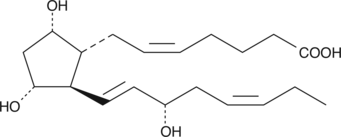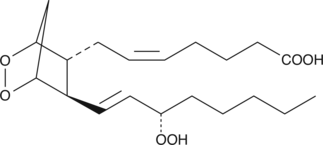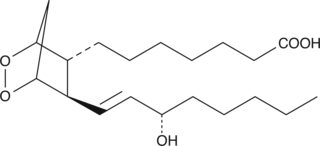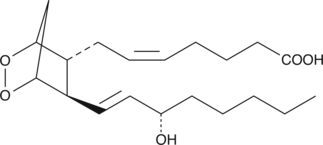Chemicals
Showing 33151–33300 of 41137 results
-
Prostaglandin F2β (PGF2β) (tromethamine salt) is a derivative of PGF2β (Item No. 16410) with increased water solubility. PGF2β is the 9β-hydroxy stereoisomer of PGF2α (Item No. 16010). It is much less active than PGF2α in antifertility and bronchoconstrictor activities.{1925,2121,633} PGF2β exhibits bronchodilating activity in guinea pigs and cats and antagonizes the bronchoconstrictor activity of PGF2α.{633}
Brand:CaymanSKU:-Out of stock
Prostaglandin F2β (PGF2β) (tromethamine salt) is a derivative of PGF2β (Item No. 16410) with increased water solubility. PGF2β is the 9β-hydroxy stereoisomer of PGF2α (Item No. 16010). It is much less active than PGF2α in antifertility and bronchoconstrictor activities.{1925,2121,633} PGF2β exhibits bronchodilating activity in guinea pigs and cats and antagonizes the bronchoconstrictor activity of PGF2α.{633}
Brand:CaymanSKU:-Out of stock
Prostaglandin F2β (PGF2β) (tromethamine salt) is a derivative of PGF2β (Item No. 16410) with increased water solubility. PGF2β is the 9β-hydroxy stereoisomer of PGF2α (Item No. 16010). It is much less active than PGF2α in antifertility and bronchoconstrictor activities.{1925,2121,633} PGF2β exhibits bronchodilating activity in guinea pigs and cats and antagonizes the bronchoconstrictor activity of PGF2α.{633}
Brand:CaymanSKU:-Out of stock
Prostaglandin F2β (PGF2β) is the 9β-hydroxy stereoisomer of PGF2α (Item Nos. 16010 | 10007221). It is much less active than PGF2α in antifertility and bronchoconstrictor activities.{1925,2121,633} PGF2β exhibits bronchodilating activity in guinea pigs and cats and antagonizes the bronchoconstrictor activity of PGF2α.{633} PGF2β MaxSpec® standard is a quantitative grade standard of PGF2β (Item No. 16410) that has been prepared specifically for mass spectrometry or any application where quantitative reproducibility is required. The solution has been prepared gravimetrically and is supplied in a deactivated glass ampule sealed under argon. The concentration was verified by comparison to an independently prepared calibration standard. This PGF2β MaxSpec® standard is guaranteed to meet identity, purity, stability, and concentration specifications and is provided with a batch-specific certificate of analysis. Ongoing stability testing is performed to ensure the concentration remains accurate throughout the shelf life of the product. Note: The amount of solution added to the vial is in excess of the listed amount. Therefore, it is necessary to accurately measure volumes for preparation of calibration standards. Follow recommended storage and handling conditions to maintain product quality.
Brand:CaymanSKU:10007232 - 100 µgAvailable on backorder
PGF3α is a COX product of EPA. The biosynthesis of PGF3α from EPA was demonstrated in vitro in human and rabbit ocular tissues.{1145} It has only 25% affinity at the ovine luteal FP receptor compared to PGF2α.{2058}
Brand:CaymanSKU:-Out of stock
PGF3α is a COX product of EPA. The biosynthesis of PGF3α from EPA was demonstrated in vitro in human and rabbit ocular tissues.{1145} It has only 25% affinity at the ovine luteal FP receptor compared to PGF2α.{2058}
Brand:CaymanSKU:-Out of stock
PGF3α is a COX product of EPA. The biosynthesis of PGF3α from EPA was demonstrated in vitro in human and rabbit ocular tissues.{1145} It has only 25% affinity at the ovine luteal FP receptor compared to PGF2α.{2058}
Brand:CaymanSKU:-Out of stock
PGF3α is a COX product of EPA. The biosynthesis of PGF3α from EPA was demonstrated in vitro in human and rabbit ocular tissues.{1145} It has only 25% affinity at the ovine luteal FP receptor compared to PGF2α.{2058}
Brand:CaymanSKU:-Out of stock
Prostaglandin G2 (PGG2) is the first intermediate in the COX pathway which is stable enough to be isolated and characterized.{499} It is the C-15 hydroperoxide of PGH2. Under normal conditions, PGG2 is quickly metabolized by the peroxidase activity intrinsic to both COX-1 and -2 to give PGH2, which serves as the key precursor to the 2-series PGs and thromboxanes.{499,759}
Brand:CaymanSKU:-Out of stock
Prostaglandin G2 (PGG2) is the first intermediate in the COX pathway which is stable enough to be isolated and characterized.{499} It is the C-15 hydroperoxide of PGH2. Under normal conditions, PGG2 is quickly metabolized by the peroxidase activity intrinsic to both COX-1 and -2 to give PGH2, which serves as the key precursor to the 2-series PGs and thromboxanes.{499,759}
Brand:CaymanSKU:-Out of stock
Prostaglandin G2 (PGG2) is the first intermediate in the COX pathway which is stable enough to be isolated and characterized.{499} It is the C-15 hydroperoxide of PGH2. Under normal conditions, PGG2 is quickly metabolized by the peroxidase activity intrinsic to both COX-1 and -2 to give PGH2, which serves as the key precursor to the 2-series PGs and thromboxanes.{499,759}
Brand:CaymanSKU:-Out of stock
Prostaglandin G2 (PGG2) is the first intermediate in the COX pathway which is stable enough to be isolated and characterized.{499} It is the C-15 hydroperoxide of PGH2. Under normal conditions, PGG2 is quickly metabolized by the peroxidase activity intrinsic to both COX-1 and -2 to give PGH2, which serves as the key precursor to the 2-series PGs and thromboxanes.{499,759}
Brand:CaymanSKU:-Out of stock
Prostaglandin H1 (PGH1) is a COX metabolite of DGLA and is the precursor to all 1-series PGs and thromboxanes. PGH1 is a suicide inhibitor of platelet thromboxane synthase with a Ki of 28 µM.{49}
Brand:CaymanSKU:-Out of stock
Prostaglandin H1 (PGH1) is a COX metabolite of DGLA and is the precursor to all 1-series PGs and thromboxanes. PGH1 is a suicide inhibitor of platelet thromboxane synthase with a Ki of 28 µM.{49}
Brand:CaymanSKU:-Out of stock
Prostaglandin H1 (PGH1) is a COX metabolite of DGLA and is the precursor to all 1-series PGs and thromboxanes. PGH1 is a suicide inhibitor of platelet thromboxane synthase with a Ki of 28 µM.{49}
Brand:CaymanSKU:-Out of stock
Prostaglandin H1 (PGH1) is a COX metabolite of DGLA and is the precursor to all 1-series PGs and thromboxanes. PGH1 is a suicide inhibitor of platelet thromboxane synthase with a Ki of 28 µM.{49}
Brand:CaymanSKU:-Out of stock
Prostaglandin H2 (PGH2) was first isolated from incubations of arachidonic acid with ovine seminal vesicle microsomes, and was described as a potent vasoconstrictor.{365} PGH2 is the precursor for all 2-series PGs and thromboxanes (TXs),{187} and is a TP receptor agonist which irreversibly aggregates human platelets at 50-100 ng/ml.
Brand:CaymanSKU:-Out of stock
Prostaglandin H2 (PGH2) was first isolated from incubations of arachidonic acid with ovine seminal vesicle microsomes, and was described as a potent vasoconstrictor.{365} PGH2 is the precursor for all 2-series PGs and thromboxanes (TXs),{187} and is a TP receptor agonist which irreversibly aggregates human platelets at 50-100 ng/ml.
Brand:CaymanSKU:-Out of stock
Prostaglandin H2 (PGH2) was first isolated from incubations of arachidonic acid with ovine seminal vesicle microsomes, and was described as a potent vasoconstrictor.{365} PGH2 is the precursor for all 2-series PGs and thromboxanes (TXs),{187} and is a TP receptor agonist which irreversibly aggregates human platelets at 50-100 ng/ml.
Brand:CaymanSKU:-Out of stock
Prostaglandin H2 (PGH2) was first isolated from incubations of arachidonic acid with ovine seminal vesicle microsomes, and was described as a potent vasoconstrictor.{365} PGH2 is the precursor for all 2-series PGs and thromboxanes (TXs),{187} and is a TP receptor agonist which irreversibly aggregates human platelets at 50-100 ng/ml.
Brand:CaymanSKU:-Out of stock
Prostaglandin I2 (PGI2) is an unstable cyclooxygenase metabolite detected first in vascular endothelial cells.{502,443,933} It elevates platelet cAMP and is a potent vasodilator and inhibitor of human platelet aggregation with an IC50 of 5 nM.{4375} PGI2 is stable in basic buffers (pH=8), but it is rapidly hydrolyzed to 6-keto PGF1α in neutral or acidic solutions. The half-life is short both in vivo and in vitro, ranging from 30 seconds to a few minutes. PGI2 is administered by continuous infusion in humans for the treatment of idiopathic pulmonary hypertension.{5466}
Brand:CaymanSKU:-Available on backorder
Prostaglandin I2 (PGI2) is an unstable cyclooxygenase metabolite detected first in vascular endothelial cells.{502,443,933} It elevates platelet cAMP and is a potent vasodilator and inhibitor of human platelet aggregation with an IC50 of 5 nM.{4375} PGI2 is stable in basic buffers (pH=8), but it is rapidly hydrolyzed to 6-keto PGF1α in neutral or acidic solutions. The half-life is short both in vivo and in vitro, ranging from 30 seconds to a few minutes. PGI2 is administered by continuous infusion in humans for the treatment of idiopathic pulmonary hypertension.{5466}
Brand:CaymanSKU:-Available on backorder
Prostaglandin I2 (PGI2) is an unstable cyclooxygenase metabolite detected first in vascular endothelial cells.{502,443,933} It elevates platelet cAMP and is a potent vasodilator and inhibitor of human platelet aggregation with an IC50 of 5 nM.{4375} PGI2 is stable in basic buffers (pH=8), but it is rapidly hydrolyzed to 6-keto PGF1α in neutral or acidic solutions. The half-life is short both in vivo and in vitro, ranging from 30 seconds to a few minutes. PGI2 is administered by continuous infusion in humans for the treatment of idiopathic pulmonary hypertension.{5466}
Brand:CaymanSKU:-Available on backorder
Prostaglandin I2 (PGI2) is an unstable cyclooxygenase metabolite detected first in vascular endothelial cells.{502,443,933} It elevates platelet cAMP and is a potent vasodilator and inhibitor of human platelet aggregation with an IC50 of 5 nM.{4375} PGI2 is stable in basic buffers (pH=8), but it is rapidly hydrolyzed to 6-keto PGF1α in neutral or acidic solutions. The half-life is short both in vivo and in vitro, ranging from 30 seconds to a few minutes. PGI2 is administered by continuous infusion in humans for the treatment of idiopathic pulmonary hypertension.{5466}
Brand:CaymanSKU:-Available on backorder
PGI3 is synthesized from EPA by COX and PGI synthase. PGI3 has a short in vivo half-life and is hydrolyzed to Δ17-6-keto PGF1α. The platelet and vascular activity of PGI3 is equivalent to that of PGI2.{1529,697}
Brand:CaymanSKU:-Available on backorder
PGI3 is synthesized from EPA by COX and PGI synthase. PGI3 has a short in vivo half-life and is hydrolyzed to Δ17-6-keto PGF1α. The platelet and vascular activity of PGI3 is equivalent to that of PGI2.{1529,697}
Brand:CaymanSKU:-Available on backorder
PGI3 is synthesized from EPA by COX and PGI synthase. PGI3 has a short in vivo half-life and is hydrolyzed to Δ17-6-keto PGF1α. The platelet and vascular activity of PGI3 is equivalent to that of PGI2.{1529,697}
Brand:CaymanSKU:-Available on backorder
PGI3 is synthesized from EPA by COX and PGI synthase. PGI3 has a short in vivo half-life and is hydrolyzed to Δ17-6-keto PGF1α. The platelet and vascular activity of PGI3 is equivalent to that of PGI2.{1529,697}
Brand:CaymanSKU:-Available on backorder
Prostaglandin J2 (PGJ2) is formed from PGD2 by the elimination of the C-9 hydroxyl group, a process which is accelerated by the presence of albumin.{1742} PGJ2 inhibits platelet aggregation with an IC50 of about 5-10 nM.{1139,504} PGJ2 has antimitotic and antiproliferative effects on a variety of cultured normal cells and tumor cell lines.{870} However, this activity has been attributed to further metabolites of PGJ2 and not the parent compound itself.
Brand:CaymanSKU:-Available on backorder
Prostaglandin J2 (PGJ2) is formed from PGD2 by the elimination of the C-9 hydroxyl group, a process which is accelerated by the presence of albumin.{1742} PGJ2 inhibits platelet aggregation with an IC50 of about 5-10 nM.{1139,504} PGJ2 has antimitotic and antiproliferative effects on a variety of cultured normal cells and tumor cell lines.{870} However, this activity has been attributed to further metabolites of PGJ2 and not the parent compound itself.
Brand:CaymanSKU:-Available on backorder
Prostaglandin J2 (PGJ2) is formed from PGD2 by the elimination of the C-9 hydroxyl group, a process which is accelerated by the presence of albumin.{1742} PGJ2 inhibits platelet aggregation with an IC50 of about 5-10 nM.{1139,504} PGJ2 has antimitotic and antiproliferative effects on a variety of cultured normal cells and tumor cell lines.{870} However, this activity has been attributed to further metabolites of PGJ2 and not the parent compound itself.
Brand:CaymanSKU:-Available on backorder
Prostaglandin J2 (PGJ2) is formed from PGD2 by the elimination of the C-9 hydroxyl group, a process which is accelerated by the presence of albumin.{1742} PGJ2 inhibits platelet aggregation with an IC50 of about 5-10 nM.{1139,504} PGJ2 has antimitotic and antiproliferative effects on a variety of cultured normal cells and tumor cell lines.{870} However, this activity has been attributed to further metabolites of PGJ2 and not the parent compound itself.
Brand:CaymanSKU:-Available on backorder
PGK1 is the 9,11-diketone formed by the oxidation of PGE1 or PGD1. Whether this compound exists biologically is uncertain; it is known to be resistant to metabolism by 15-hydroxy PGDH in vitro.{1789} In an intact porcine model of balloon angioplasty restenosis, PGK1 was equivalent in activity and potency to PGE1.{6703}
Brand:CaymanSKU:-Available on backorder
PGK1 is the 9,11-diketone formed by the oxidation of PGE1 or PGD1. Whether this compound exists biologically is uncertain; it is known to be resistant to metabolism by 15-hydroxy PGDH in vitro.{1789} In an intact porcine model of balloon angioplasty restenosis, PGK1 was equivalent in activity and potency to PGE1.{6703}
Brand:CaymanSKU:-Available on backorder
PGK1 is the 9,11-diketone formed by the oxidation of PGE1 or PGD1. Whether this compound exists biologically is uncertain; it is known to be resistant to metabolism by 15-hydroxy PGDH in vitro.{1789} In an intact porcine model of balloon angioplasty restenosis, PGK1 was equivalent in activity and potency to PGE1.{6703}
Brand:CaymanSKU:-Available on backorder
PGK1 is the 9,11-diketone formed by the oxidation of PGE1 or PGD1. Whether this compound exists biologically is uncertain; it is known to be resistant to metabolism by 15-hydroxy PGDH in vitro.{1789} In an intact porcine model of balloon angioplasty restenosis, PGK1 was equivalent in activity and potency to PGE1.{6703}
Brand:CaymanSKU:-Available on backorder
Prostaglandin K2 (PGK2) is the 9,11-diketone formed by the oxidation of PGE2 or PGD2. Whether this compound exists biologically is uncertain; it is known to be resistant to metabolism by 15-hydroxy PGDH in vitro.{1789}
Brand:CaymanSKU:-Available on backorder
Prostaglandin K2 (PGK2) is the 9,11-diketone formed by the oxidation of PGE2 or PGD2. Whether this compound exists biologically is uncertain; it is known to be resistant to metabolism by 15-hydroxy PGDH in vitro.{1789}
Brand:CaymanSKU:-Available on backorder
Prostaglandin K2 (PGK2) is the 9,11-diketone formed by the oxidation of PGE2 or PGD2. Whether this compound exists biologically is uncertain; it is known to be resistant to metabolism by 15-hydroxy PGDH in vitro.{1789}
Brand:CaymanSKU:-Available on backorder
Prostaglandin K2 (PGK2) is the 9,11-diketone formed by the oxidation of PGE2 or PGD2. Whether this compound exists biologically is uncertain; it is known to be resistant to metabolism by 15-hydroxy PGDH in vitro.{1789}
Brand:CaymanSKU:-Available on backorder
Activation of latent reservoirs of HIV-infected cells is a treatment strategy designed to reduce viral load and eliminate the perpetuation of retroviral infection. Prostratin is a non-tumor promoting phorbol ester that potently induces HIV-1 reactivation in latent reservoirs of infected Jurkat-LAT-GFP cells with an IC50 value of ~0.5 µM.{17117} Originally, prostratin was isolated from plant sources including P. prostrata, E. cornigera, and H. nutans. {15812} The effects of prostratin are mediated through activation of NF-κB via protein kinase C and by downregulation of HIV-1 receptor CD4 expression and its co-receptors CXCR4 and CCR5.{17116,17118,17119}
Brand:CaymanSKU:10272 - 1 mgAvailable on backorder
Activation of latent reservoirs of HIV-infected cells is a treatment strategy designed to reduce viral load and eliminate the perpetuation of retroviral infection. Prostratin is a non-tumor promoting phorbol ester that potently induces HIV-1 reactivation in latent reservoirs of infected Jurkat-LAT-GFP cells with an IC50 value of ~0.5 µM.{17117} Originally, prostratin was isolated from plant sources including P. prostrata, E. cornigera, and H. nutans. {15812} The effects of prostratin are mediated through activation of NF-κB via protein kinase C and by downregulation of HIV-1 receptor CD4 expression and its co-receptors CXCR4 and CCR5.{17116,17118,17119}
Brand:CaymanSKU:10272 - 10 mgAvailable on backorder
Activation of latent reservoirs of HIV-infected cells is a treatment strategy designed to reduce viral load and eliminate the perpetuation of retroviral infection. Prostratin is a non-tumor promoting phorbol ester that potently induces HIV-1 reactivation in latent reservoirs of infected Jurkat-LAT-GFP cells with an IC50 value of ~0.5 µM.{17117} Originally, prostratin was isolated from plant sources including P. prostrata, E. cornigera, and H. nutans. {15812} The effects of prostratin are mediated through activation of NF-κB via protein kinase C and by downregulation of HIV-1 receptor CD4 expression and its co-receptors CXCR4 and CCR5.{17116,17118,17119}
Brand:CaymanSKU:10272 - 5 mgAvailable on backorder
Activation of latent reservoirs of HIV-infected cells is a treatment strategy designed to reduce viral load and eliminate the perpetuation of retroviral infection. Prostratin is a non-tumor promoting phorbol ester that potently induces HIV-1 reactivation in latent reservoirs of infected Jurkat-LAT-GFP cells with an IC50 value of ~0.5 µM.{17117} Originally, prostratin was isolated from plant sources including P. prostrata, E. cornigera, and H. nutans. {15812} The effects of prostratin are mediated through activation of NF-κB via protein kinase C and by downregulation of HIV-1 receptor CD4 expression and its co-receptors CXCR4 and CCR5.{17116,17118,17119}
Brand:CaymanSKU:10272 - 500 µgAvailable on backorder
proTAME is a cell-permeable prodrug form of N-4-tosyl-L-arginine methyl ester (TAME; Item No. 17550), an inhibitor of the anaphase-promoting complex/cyclosome (APC/C), that is converted to TAME by intracellular esterases.{28533,36286} proTAME (12 μM) blocks association of APC/C with the activator CDH1 and inhibits degradation of APC/C substrates in HeLa cells.{28533} It induces mitotic arrest in metaphase followed by cell death in synchronized HeLa H2B-GFP cells when used at a concentration of 12 μM. It also increases mitotic duration in asynchronous HeLa H2B-GFP cells at a concentration of 4 μM, an effect that is enhanced by knockdown of the APC/C co-activator CDC20. proTAME decreases the viability of several laboratory and primary patient-derived human multiple myeloma (MM) cell lines (IC50s = 2.8-20.3 μM) and increases apoptosis in RPMI-8226, LP-1, NCI-H929, and U266 MM cells when used at a concentration of 12 μM.{36286}
Brand:CaymanSKU:25835 - 1 mgAvailable on backorder
Protectin D1 is a specialized pro-resolving mediator (SPM) synthesized from docosahexaenoic acid (DHA; Item No. 90310).{38180} DHA is oxidized to 16S,17S-epoxy-protectin, which is converted to protectin D1 enzymatically. Protectin D1 increases phagocytosis of apoptotic polymorphonuclear leukocytes (PMNs) by macrophages in a non-phlogistic manner and is generated in vitro during macrophage-apoptotic interactions.{14972} It enhances phagocytosis in mice after 24 hours, but not at the initiation or peak of inflammation. It also decreases PMN infiltration in a zymosan-induced mouse model of inflammation when administered at a dose of 300 ng per animal. Protectin D1 (200 µg, i.v.) inhibits increases in neutrophil counts in bronchoalveolar fluid (BALF) and lung myeloperoxidase activity in a mouse model of pulmonary injury and inflammation induced by intratracheal LPS instillation.{48017} It also decreases pulmonary edema and promotes neutrophil apoptosis in BALF.
Brand:CaymanSKU:10010390 - 10 µgAvailable on backorder
Protectin D1 is a specialized pro-resolving mediator (SPM) synthesized from docosahexaenoic acid (DHA; Item No. 90310).{38180} DHA is oxidized to 16S,17S-epoxy-protectin, which is converted to protectin D1 enzymatically. Protectin D1 increases phagocytosis of apoptotic polymorphonuclear leukocytes (PMNs) by macrophages in a non-phlogistic manner and is generated in vitro during macrophage-apoptotic interactions.{14972} It enhances phagocytosis in mice after 24 hours, but not at the initiation or peak of inflammation. It also decreases PMN infiltration in a zymosan-induced mouse model of inflammation when administered at a dose of 300 ng per animal. Protectin D1 (200 µg, i.v.) inhibits increases in neutrophil counts in bronchoalveolar fluid (BALF) and lung myeloperoxidase activity in a mouse model of pulmonary injury and inflammation induced by intratracheal LPS instillation.{48017} It also decreases pulmonary edema and promotes neutrophil apoptosis in BALF.
Brand:CaymanSKU:10010390 - 100 µgAvailable on backorder
Protectin D1 is a specialized pro-resolving mediator (SPM) synthesized from docosahexaenoic acid (DHA; Item No. 90310).{38180} DHA is oxidized to 16S,17S-epoxy-protectin, which is converted to protectin D1 enzymatically. Protectin D1 increases phagocytosis of apoptotic polymorphonuclear leukocytes (PMNs) by macrophages in a non-phlogistic manner and is generated in vitro during macrophage-apoptotic interactions.{14972} It enhances phagocytosis in mice after 24 hours, but not at the initiation or peak of inflammation. It also decreases PMN infiltration in a zymosan-induced mouse model of inflammation when administered at a dose of 300 ng per animal. Protectin D1 (200 µg, i.v.) inhibits increases in neutrophil counts in bronchoalveolar fluid (BALF) and lung myeloperoxidase activity in a mouse model of pulmonary injury and inflammation induced by intratracheal LPS instillation.{48017} It also decreases pulmonary edema and promotes neutrophil apoptosis in BALF.
Brand:CaymanSKU:10010390 - 25 µgAvailable on backorder
Protectin D1 is a specialized pro-resolving mediator (SPM) synthesized from docosahexaenoic acid (DHA; Item No. 90310).{38180} DHA is oxidized to 16S,17S-epoxy-protectin, which is converted to protectin D1 enzymatically. Protectin D1 increases phagocytosis of apoptotic polymorphonuclear leukocytes (PMNs) by macrophages in a non-phlogistic manner and is generated in vitro during macrophage-apoptotic interactions.{14972} It enhances phagocytosis in mice after 24 hours, but not at the initiation or peak of inflammation. It also decreases PMN infiltration in a zymosan-induced mouse model of inflammation when administered at a dose of 300 ng per animal. Protectin D1 (200 µg, i.v.) inhibits increases in neutrophil counts in bronchoalveolar fluid (BALF) and lung myeloperoxidase activity in a mouse model of pulmonary injury and inflammation induced by intratracheal LPS instillation.{48017} It also decreases pulmonary edema and promotes neutrophil apoptosis in BALF.
Brand:CaymanSKU:10010390 - 50 µgAvailable on backorder
Prothionamide is a bactericidal thioamide effective against M. tuberculosis (MIC = ~0.5 µg/ml), M. leprae (MIC = 0.8-1.6 mg/L), and M. avium.{26434} It forms a covalent adduct with nicotinamide adenine dinucleotide that inhibits mycobacterial InhA, the enoyl-acyl ACP reductase involved in mycolic acid biosynthesis, with a Ki value of 2 nM.{26434}
Brand:CaymanSKU:-Prothionamide is a bactericidal thioamide effective against M. tuberculosis (MIC = ~0.5 µg/ml), M. leprae (MIC = 0.8-1.6 mg/L), and M. avium.{26434} It forms a covalent adduct with nicotinamide adenine dinucleotide that inhibits mycobacterial InhA, the enoyl-acyl ACP reductase involved in mycolic acid biosynthesis, with a Ki value of 2 nM.{26434}
Brand:CaymanSKU:-Prothionamide is a bactericidal thioamide effective against M. tuberculosis (MIC = ~0.5 µg/ml), M. leprae (MIC = 0.8-1.6 mg/L), and M. avium.{26434} It forms a covalent adduct with nicotinamide adenine dinucleotide that inhibits mycobacterial InhA, the enoyl-acyl ACP reductase involved in mycolic acid biosynthesis, with a Ki value of 2 nM.{26434}
Brand:CaymanSKU:-Prothionamide is a bactericidal thioamide effective against M. tuberculosis (MIC = ~0.5 µg/ml), M. leprae (MIC = 0.8-1.6 mg/L), and M. avium.{26434} It forms a covalent adduct with nicotinamide adenine dinucleotide that inhibits mycobacterial InhA, the enoyl-acyl ACP reductase involved in mycolic acid biosynthesis, with a Ki value of 2 nM.{26434}
Brand:CaymanSKU:-Protocatechuic acid (PCA) is a dihydroxybenzoic acid phenolic compound found in many edible and medicinal plants. It is a major metabolite of antioxidant polyphenols found in green tea and demonstrates free radical scavenging capability in a 1,1-diphenyl-2-picrylhydrazyl radical scavenging activity assay (IC50 = 16.3 μM).{23837,23838} It is thought to possess anti-inflammatory, antihyperglycemic, neuroprotective, and anticancer activities. Dietary administration of PCA dose dependently inhibits in vitro chemical carcinogenesis and exerts pro-apoptotic and anti-proliferative effects in different tissues.{23839} In studies of tumor cell migration and invasion using mouse melanoma B16/F10 cells, PCA at 0.1-2 mM down-regulated the Ras/Akt/NF-κB pathway by targeting RhoB activation, leading to a reduction of MMP-mediated activity.{23836}
Brand:CaymanSKU:-Protocatechuic acid (PCA) is a dihydroxybenzoic acid phenolic compound found in many edible and medicinal plants. It is a major metabolite of antioxidant polyphenols found in green tea and demonstrates free radical scavenging capability in a 1,1-diphenyl-2-picrylhydrazyl radical scavenging activity assay (IC50 = 16.3 μM).{23837,23838} It is thought to possess anti-inflammatory, antihyperglycemic, neuroprotective, and anticancer activities. Dietary administration of PCA dose dependently inhibits in vitro chemical carcinogenesis and exerts pro-apoptotic and anti-proliferative effects in different tissues.{23839} In studies of tumor cell migration and invasion using mouse melanoma B16/F10 cells, PCA at 0.1-2 mM down-regulated the Ras/Akt/NF-κB pathway by targeting RhoB activation, leading to a reduction of MMP-mediated activity.{23836}
Brand:CaymanSKU:-Protocatechuic acid (PCA) is a dihydroxybenzoic acid phenolic compound found in many edible and medicinal plants. It is a major metabolite of antioxidant polyphenols found in green tea and demonstrates free radical scavenging capability in a 1,1-diphenyl-2-picrylhydrazyl radical scavenging activity assay (IC50 = 16.3 μM).{23837,23838} It is thought to possess anti-inflammatory, antihyperglycemic, neuroprotective, and anticancer activities. Dietary administration of PCA dose dependently inhibits in vitro chemical carcinogenesis and exerts pro-apoptotic and anti-proliferative effects in different tissues.{23839} In studies of tumor cell migration and invasion using mouse melanoma B16/F10 cells, PCA at 0.1-2 mM down-regulated the Ras/Akt/NF-κB pathway by targeting RhoB activation, leading to a reduction of MMP-mediated activity.{23836}
Brand:CaymanSKU:-Protodioscin is a steroidal saponin first isolated from plants used in herbal remedies. It displays cytotoxicity against a range of cancer cells in vitro, including leukemia, colon cancer, and prostate cancer cells (GI50 ≤ 2 µM).{30394} Protodioscin, as a part of an extract from the plant T. terrestris, also improves sexual behavior parameters in rats.{30393}
Brand:CaymanSKU:11887 - 1 mgAvailable on backorder
Protodioscin is a steroidal saponin first isolated from plants used in herbal remedies. It displays cytotoxicity against a range of cancer cells in vitro, including leukemia, colon cancer, and prostate cancer cells (GI50 ≤ 2 µM).{30394} Protodioscin, as a part of an extract from the plant T. terrestris, also improves sexual behavior parameters in rats.{30393}
Brand:CaymanSKU:11887 - 10 mgAvailable on backorder
Protodioscin is a steroidal saponin first isolated from plants used in herbal remedies. It displays cytotoxicity against a range of cancer cells in vitro, including leukemia, colon cancer, and prostate cancer cells (GI50 ≤ 2 µM).{30394} Protodioscin, as a part of an extract from the plant T. terrestris, also improves sexual behavior parameters in rats.{30393}
Brand:CaymanSKU:11887 - 5 mgAvailable on backorder
Protodioscin is a steroidal saponin first isolated from plants used in herbal remedies. It displays cytotoxicity against a range of cancer cells in vitro, including leukemia, colon cancer, and prostate cancer cells (GI50 ≤ 2 µM).{30394} Protodioscin, as a part of an extract from the plant T. terrestris, also improves sexual behavior parameters in rats.{30393}
Brand:CaymanSKU:11887 - 50 mgAvailable on backorder
Protogracillin is a steroid saponin originally isolated from T. terrestris.{46012} It is cytotoxic to K562 cells (IC50 = 3.3 µM).{46013}
Brand:CaymanSKU:11893 - 1 mgAvailable on backorder
Protogracillin is a steroid saponin originally isolated from T. terrestris.{46012} It is cytotoxic to K562 cells (IC50 = 3.3 µM).{46013}
Brand:CaymanSKU:11893 - 10 mgAvailable on backorder
Protogracillin is a steroid saponin originally isolated from T. terrestris.{46012} It is cytotoxic to K562 cells (IC50 = 3.3 µM).{46013}
Brand:CaymanSKU:11893 - 5 mgAvailable on backorder
Protonitazene (hydrochloride) (Item No. 29381) is an analytical reference standard that is structurally similar to known opioids. This product is intended for research and forensic applications.
Brand:CaymanSKU:29381 - 1 mgAvailable on backorder
Protonitazene (hydrochloride) (Item No. 29381) is an analytical reference standard that is structurally similar to known opioids. This product is intended for research and forensic applications.
Brand:CaymanSKU:29381 - 5 mgAvailable on backorder
Protopine is an alkaloid found in Berberidaceae, Ranunculaceae, Rutaceae, Fumariaceae, and Papaveraceae with diverse biological activities.{41158} It inhibits platelet aggregation induced by ADP, arachidonic acid (Item Nos. 90010 | 90010.1 | 10006607), platelet-activating factor (PAF), and collagen in rabbit platelet-rich plasma at a concentration of 100 μM.{41159} Protopine inhibits contraction of isolated rat thoracic aorta induced by norepinephrine (Item No. 16673) and is a non-selective inhibitor of ICa, IK, IK1, and INa in guinea pig ventricular myocytes.{41160,41161} Protopine inhibits the growth of H. pylori with an MIC50 value of 100 μg/ml.{41162} It reduces growth of PC3 and DU145 prostate cancer cells in a dose-dependent manner via induction of mitotic cell cycle arrest.{41163} Protopine (0.005 mg/kg) increases latency to first seizure in a mouse model induced by pentylenetetrazole (Item No. 18682).{41164}
Brand:CaymanSKU:23366 - 1 mgAvailable on backorder
Protopine is an alkaloid found in Berberidaceae, Ranunculaceae, Rutaceae, Fumariaceae, and Papaveraceae with diverse biological activities.{41158} It inhibits platelet aggregation induced by ADP, arachidonic acid (Item Nos. 90010 | 90010.1 | 10006607), platelet-activating factor (PAF), and collagen in rabbit platelet-rich plasma at a concentration of 100 μM.{41159} Protopine inhibits contraction of isolated rat thoracic aorta induced by norepinephrine (Item No. 16673) and is a non-selective inhibitor of ICa, IK, IK1, and INa in guinea pig ventricular myocytes.{41160,41161} Protopine inhibits the growth of H. pylori with an MIC50 value of 100 μg/ml.{41162} It reduces growth of PC3 and DU145 prostate cancer cells in a dose-dependent manner via induction of mitotic cell cycle arrest.{41163} Protopine (0.005 mg/kg) increases latency to first seizure in a mouse model induced by pentylenetetrazole (Item No. 18682).{41164}
Brand:CaymanSKU:23366 - 500 µgAvailable on backorder
Protriptyline is a tricyclic antidepressant.{22877} It binds to the norepinephrine and serotonin (5-HT) transporters with Kd values of 1.41 and 19.6 nM, respectively. Protriptyline also binds to histamine H1, muscarinic acetylcholine, and α1-adrenergic receptors (Kds = 25, 25, and 130 nM, respectively).{25914} It inhibits norepinephrine uptake into rat whole brain and hypothalamic synaptosomes (IC50s = 12 and 0.55 μM, respectively) and 5-HT uptake into rat whole brain synaptosomes (IC50 = 5.5 μM).{54252} Protriptyline (1 mg/kg, i.v.) inhibits food-induced cataplexy in narcoleptic dogs.{46726} Formulations containing protriptyline have been used in the treatment of depression.
Brand:CaymanSKU:31179 - 10 mgAvailable on backorder
Protriptyline is a tricyclic antidepressant.{22877} It binds to the norepinephrine and serotonin (5-HT) transporters with Kd values of 1.41 and 19.6 nM, respectively. Protriptyline also binds to histamine H1, muscarinic acetylcholine, and α1-adrenergic receptors (Kds = 25, 25, and 130 nM, respectively).{25914} It inhibits norepinephrine uptake into rat whole brain and hypothalamic synaptosomes (IC50s = 12 and 0.55 μM, respectively) and 5-HT uptake into rat whole brain synaptosomes (IC50 = 5.5 μM).{54252} Protriptyline (1 mg/kg, i.v.) inhibits food-induced cataplexy in narcoleptic dogs.{46726} Formulations containing protriptyline have been used in the treatment of depression.
Brand:CaymanSKU:31179 - 25 mgAvailable on backorder
Protriptyline is a tricyclic antidepressant.{22877} It binds to the norepinephrine and serotonin (5-HT) transporters with Kd values of 1.41 and 19.6 nM, respectively. Protriptyline also binds to histamine H1, muscarinic acetylcholine, and α1-adrenergic receptors (Kds = 25, 25, and 130 nM, respectively).{25914} It inhibits norepinephrine uptake into rat whole brain and hypothalamic synaptosomes (IC50s = 12 and 0.55 μM, respectively) and 5-HT uptake into rat whole brain synaptosomes (IC50 = 5.5 μM).{54252} Protriptyline (1 mg/kg, i.v.) inhibits food-induced cataplexy in narcoleptic dogs.{46726} Formulations containing protriptyline have been used in the treatment of depression.
Brand:CaymanSKU:31179 - 5 mgAvailable on backorder
Protriptyline is a tricyclic antidepressant.{22877} It binds to the norepinephrine and serotonin (5-HT) transporters with Kd values of 1.41 and 19.6 nM, respectively. Protriptyline also binds to histamine H1, muscarinic acetylcholine, and α1-adrenergic receptors (Kds = 25, 25, and 130 nM, respectively).{25914} It inhibits norepinephrine uptake into rat whole brain and hypothalamic synaptosomes (IC50s = 12 and 0.55 μM, respectively) and 5-HT uptake into rat whole brain synaptosomes (IC50 = 5.5 μM).{54252} Protriptyline (1 mg/kg, i.v.) inhibits food-induced cataplexy in narcoleptic dogs.{46726} Formulations containing protriptyline have been used in the treatment of depression.
Brand:CaymanSKU:31179 - 50 mgAvailable on backorder
Proxyphylline is a methylxanthine derivative that has bronchodilatory actions.{32897} It has also been reported to have vasodilatory and cardiac stimulatory effects.{32898} Proxyphylline selectively antagonizes A1 adenosine receptors (Ki = 82 nM for bovine brain) versus A2 adenosine receptors (Ki = 850 µM for platelets).{29142} Proxyphylline has been mixed with Melilotus extract to generate a theo-esberiven product, which can have cardiovascular and anti-allodynia effects in mammals.{32898,32896}
Brand:CaymanSKU:20937 -Out of stock
Proxyphylline is a methylxanthine derivative that has bronchodilatory actions.{32897} It has also been reported to have vasodilatory and cardiac stimulatory effects.{32898} Proxyphylline selectively antagonizes A1 adenosine receptors (Ki = 82 nM for bovine brain) versus A2 adenosine receptors (Ki = 850 µM for platelets).{29142} Proxyphylline has been mixed with Melilotus extract to generate a theo-esberiven product, which can have cardiovascular and anti-allodynia effects in mammals.{32898,32896}
Brand:CaymanSKU:20937 -Out of stock
Proxyphylline is a methylxanthine derivative that has bronchodilatory actions.{32897} It has also been reported to have vasodilatory and cardiac stimulatory effects.{32898} Proxyphylline selectively antagonizes A1 adenosine receptors (Ki = 82 nM for bovine brain) versus A2 adenosine receptors (Ki = 850 µM for platelets).{29142} Proxyphylline has been mixed with Melilotus extract to generate a theo-esberiven product, which can have cardiovascular and anti-allodynia effects in mammals.{32898,32896}
Brand:CaymanSKU:20937 -Out of stock
Proxyphylline is a methylxanthine derivative that has bronchodilatory actions.{32897} It has also been reported to have vasodilatory and cardiac stimulatory effects.{32898} Proxyphylline selectively antagonizes A1 adenosine receptors (Ki = 82 nM for bovine brain) versus A2 adenosine receptors (Ki = 850 µM for platelets).{29142} Proxyphylline has been mixed with Melilotus extract to generate a theo-esberiven product, which can have cardiovascular and anti-allodynia effects in mammals.{32898,32896}
Brand:CaymanSKU:20937 -Out of stock
PRT060318 is a potent and selective inhibitor of spleen tyrosine kinase (Syk; IC50 = 4 nM).{39127,39128} It is selective, inhibiting 92% of Syk activity, while other kinases retain >70% activity, at a concentration of 50 nM in a panel of 270 kinases.{39128} PRT060318 inhibits convulxin-induced aggregation of human platelet-rich plasma (IC50 = 2.5 μM) in vitro and prevents thrombosis in a transgenic mouse model of heparin-induced thrombocytopenia. It induces chronic lymphocytic leukemia (CLL) B cell apoptosis and inhibits the secretion of chemokines CCL3, CCL4, and CXCL13.{39219} PRT060318 also inhibits CLL B cell chemotaxis and pseudoemperipolesis.
Brand:CaymanSKU:22476 -Out of stock
PRT060318 is a potent and selective inhibitor of spleen tyrosine kinase (Syk; IC50 = 4 nM).{39127,39128} It is selective, inhibiting 92% of Syk activity, while other kinases retain >70% activity, at a concentration of 50 nM in a panel of 270 kinases.{39128} PRT060318 inhibits convulxin-induced aggregation of human platelet-rich plasma (IC50 = 2.5 μM) in vitro and prevents thrombosis in a transgenic mouse model of heparin-induced thrombocytopenia. It induces chronic lymphocytic leukemia (CLL) B cell apoptosis and inhibits the secretion of chemokines CCL3, CCL4, and CXCL13.{39219} PRT060318 also inhibits CLL B cell chemotaxis and pseudoemperipolesis.
Brand:CaymanSKU:22476 -Out of stock
PRT060318 is a potent and selective inhibitor of spleen tyrosine kinase (Syk; IC50 = 4 nM).{39127,39128} It is selective, inhibiting 92% of Syk activity, while other kinases retain >70% activity, at a concentration of 50 nM in a panel of 270 kinases.{39128} PRT060318 inhibits convulxin-induced aggregation of human platelet-rich plasma (IC50 = 2.5 μM) in vitro and prevents thrombosis in a transgenic mouse model of heparin-induced thrombocytopenia. It induces chronic lymphocytic leukemia (CLL) B cell apoptosis and inhibits the secretion of chemokines CCL3, CCL4, and CXCL13.{39219} PRT060318 also inhibits CLL B cell chemotaxis and pseudoemperipolesis.
Brand:CaymanSKU:22476 -Out of stock
BMI1/RING1A and BMI1/RNF2 are E3 ubiquitin ligase complexes that mediate the monoubiquitination of histone 2A (H2A). This is an essential function of polycomb repressive complex 1 (PRC1).{30718} PRT4165 is an inhibitor of the ubiquitin ligase activity of PRC1.{30882,30883} It blocks BMI1/RING1A self-ubiquitination (IC50 = 3.9 µM), as well as polyubiquitination of topoisomerase 2α in cells.{30882} PRT4165 inhibits ubiquitination of H2A by either RNF2 or RING1. Through these actions, PRT4165 prevents the accumulation of detectable ubiquitin at DNA double-strand breaks, the retention of response proteins around breaks, and the repair of breaks.{30883}
Brand:CaymanSKU:-Available on backorder
BMI1/RING1A and BMI1/RNF2 are E3 ubiquitin ligase complexes that mediate the monoubiquitination of histone 2A (H2A). This is an essential function of polycomb repressive complex 1 (PRC1).{30718} PRT4165 is an inhibitor of the ubiquitin ligase activity of PRC1.{30882,30883} It blocks BMI1/RING1A self-ubiquitination (IC50 = 3.9 µM), as well as polyubiquitination of topoisomerase 2α in cells.{30882} PRT4165 inhibits ubiquitination of H2A by either RNF2 or RING1. Through these actions, PRT4165 prevents the accumulation of detectable ubiquitin at DNA double-strand breaks, the retention of response proteins around breaks, and the repair of breaks.{30883}
Brand:CaymanSKU:-Available on backorder
BMI1/RING1A and BMI1/RNF2 are E3 ubiquitin ligase complexes that mediate the monoubiquitination of histone 2A (H2A). This is an essential function of polycomb repressive complex 1 (PRC1).{30718} PRT4165 is an inhibitor of the ubiquitin ligase activity of PRC1.{30882,30883} It blocks BMI1/RING1A self-ubiquitination (IC50 = 3.9 µM), as well as polyubiquitination of topoisomerase 2α in cells.{30882} PRT4165 inhibits ubiquitination of H2A by either RNF2 or RING1. Through these actions, PRT4165 prevents the accumulation of detectable ubiquitin at DNA double-strand breaks, the retention of response proteins around breaks, and the repair of breaks.{30883}
Brand:CaymanSKU:-Available on backorder























